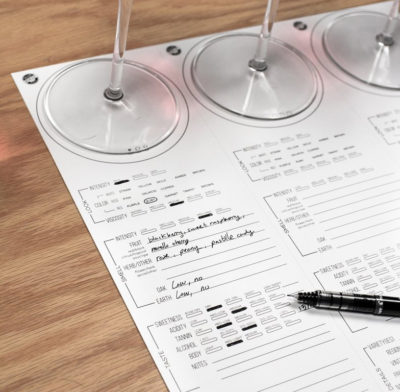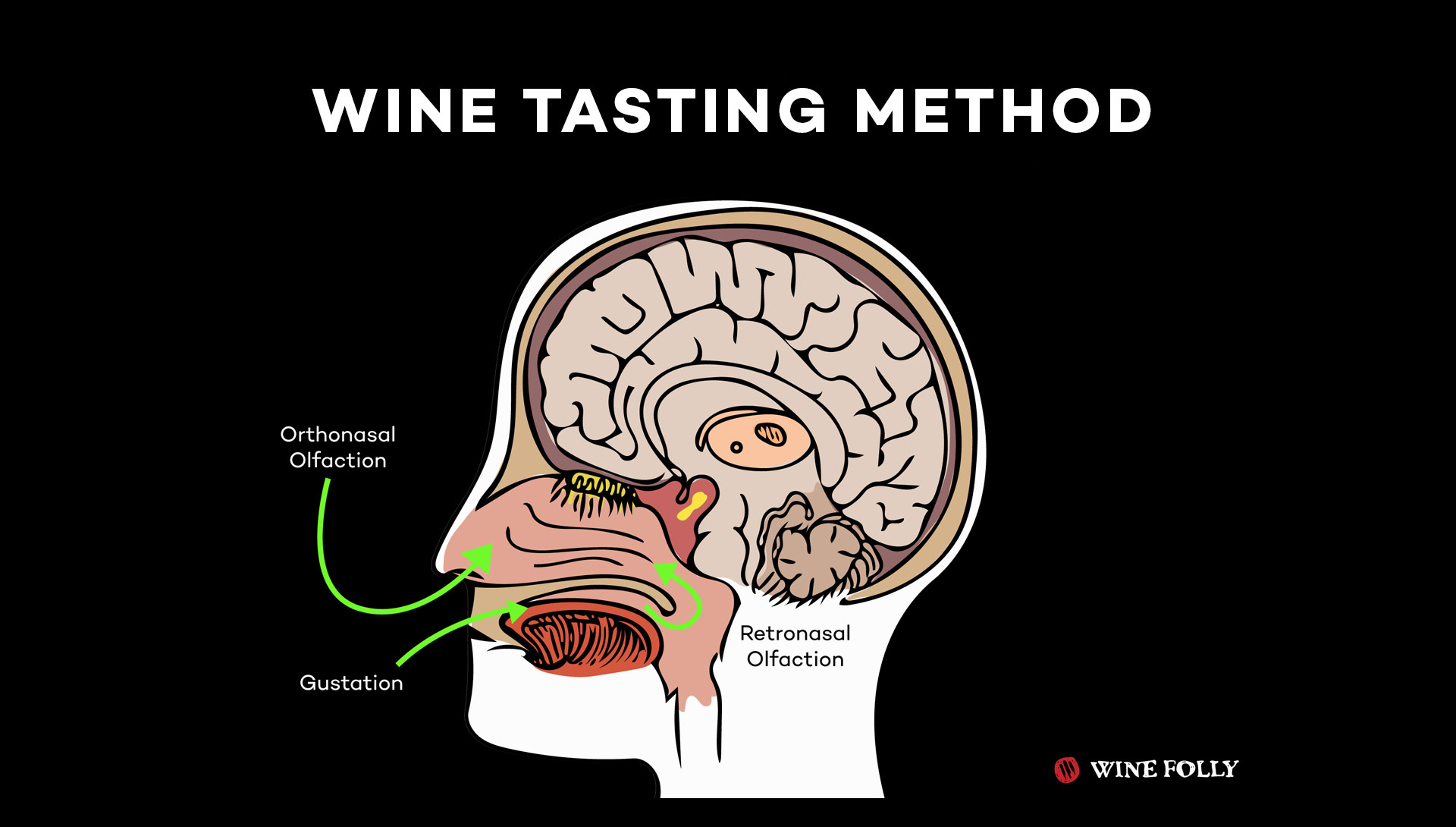The wine tasting method is a simple process that will help you identify specific characteristics of a wine while tasting it. This video will teach you how to taste using this professional method. Anyone can do it, and it’s easy to learn how. Just grab a glass of wine and follow along with the video below!
Below are detailed notes on the wine tasting method so you can practice along!
Look
Your eyes will help you size up a glass of wine before you even sniff it. Here’s what to do:
- Hue and Intensity: Identify the wine’s most prominent color as a point of reference. See the wine color chart for a complete list of hues.
- Tears/Legs: When you swirl the wine, you will see tears develop on the sides of the glass. It is a phenomenon called the Gibbs-Marangoni Effect and indicates the presence of alcohol in the wine. Increased tearing is an indication of a higher alcohol level.

Wine Tasting Placemats
We designed these wine tasting placemats specifically to help train your palate with the 4-step tasting method.
Buy Now
Smell
There are hundreds of aroma compounds found in wine. As we learn to smell wine, we become more adept at isolating and identifying these aromas. Try to identify the smells to get a clear impression of the wine before you taste it.
- Intensity: Position the glass just below your nose and take a quick, light whiff to judge the intensity. If the wine is highly aromatic, you will be able to smell it quite distinctly. Now position the glass where it’s most optimal for you to smell individual aromas (usually by pulling it back a bit).
- Fruit: If you’re having trouble identifying aromas besides a strong “vinous” note, try holding the glass farther away from your nose. Identify the type of fruit and also the condition of the fruit. For example, if you detect strawberry, ask yourself: is it fresh, ripe, or dried? A good goal to set is to identify 3 fruit aromas before moving on to other smells.
- Herb/Other: Note all the other aromas you smell in a wine not related to fruit. You’ll notice that some wines are distinctly more savory and have notes of herbs, flowers, and even minerals. By the way, no answer is wrong. Notes in this category can include black pepper, espresso, balsamic, petroleum, and beeswax.
- Oak: If the wine has aromas of vanilla, coconut, allspice, chocolate, cola, and cedar or cigar, it’s likely to have been aged in oak barrels. Aging wine in oak causes some flavor compounds from the barrel to transfer into the wine. Different species of oak trees affect flavors differently. For example, American oak (Quercus alba) tends to add more dill and coconut aroma, whereas European oak (Quercus Petrea) tends to contribute to vanilla, nutmeg, and allspice.
- Earth: When you taste earthiness in a wine, note whether it tastes organic (loam, forest soil, mushroom) or inorganic (slate, chalk, rocks, dried clay). These aromas, while still unexplained scientifically, offer more clues to where the grapes were grown. For example, wines from Burgundy and Champagne often have subtle, organic, mushroom aromas. A lack of earthy aromas also helps to identify (or narrow down) a wine’s potential origin.
Taste
When you taste a wine, you’ll focus on flavors and feel (how the wine feels on your palate/ in your mouth). Make sure you swish it around in your mouth to get the full effect before swallowing.
- Sweetness: Sweetness in wine is primarily from grape sugars that are leftover after fermentation, which are referred to as residual sugar (RS). Of course, our human perception of residual sugar is influenced by the other characteristics in the wine, particularly acidity. Sweetness is less perceivable in wines with higher acidity. See the sweetness levels in wine.
- Tannin: (for red wines) Tannin is a polyphenol (antioxidant) found mostly in red wine. Tannin tastes astringent and gives a drying sensation felt on your tongue. High tannin wines will grip the insides of your lips to your teeth. Tannins can taste bitter, but mostly, they are astringent and described like sandpaper: fine, medium, gritty, or grippy.
- Acidity: Acidity is the level of sourness in wine. Acidity makes your mouth water. Low acid wines generally taste round or even flabby, and high acid wines taste lighter in body and very tart. Checkout how to compare acidic to other beverages.
- Alcohol: Alcohol is felt in your throat as a warming sensation. With practice, some tasters can estimate the alcohol level within a 10th of a percent. Alcohol adds to the overall body of a wine.
- Overall Body: All the traits mentioned above come together to give you a sense of the wine’s body, which is essentially a measure of how bold it tastes in your mouth. Ask yourself if the wine is light-, medium-, or full-bodied.
- Additional Flavors: Are there any flavors you can identify while tasting the wine that you didn’t identify in its smell? Take note!

Conclusion
After you’ve tasted the wine, now you have the opportunity to consider the wine’s quality. Here are some of the questions to ask yourself:
- Is the wine in balance? This is a question referencing the notes you made in the tasting section. Wines that are “in balance” have tastes that are balanced between one-another including acidity, tannin (if it’s a red), and alcohol level. While different wines have different intensities, a quality wine will be in balance with itself.
- Is the wine complex? If you have a great deal of tasting notes for this wine and can still think of more, you’ve got a pretty complex wine on your hands.
- What is your opinion? Now that you’ve properly assessed the wine, what do you think of it (overall)? We use a very simple 3-point system for this assessment (ew, meh, yay!) but you can use any kind of rating system that works for you.
Now that you know to Look, Smell, and Taste, you’re ready to begin picking out all your favorite wine flavors and aromas. But the road to greater wine knowledge is best walked with a few trusty tools to help you recall the story of your wines.
The Wine Tasting Journal is a crucial tool for capturing all the elements of the wine you’ve tasted and your thoughts while the aroma and flavor were fresh on your palate. More than a couple of good wine bottles are out there, don’t get caught with a bottle you already know isn’t the right one for you.
